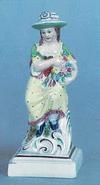- Staffordshire figure
-
a small pottery figure made in Staffordshire from the 18th century onwards. The small painted models of animals and people, often famous or historical figures, are used in people’s homes for decoration.
* * *
Type of pottery figurine made in Staffordshire, Eng., beginning с 1740. The figurines were made first in salt-glazed stoneware, later in lead-glazed earthenware. Subjects included musicians, animals, shepherds, classical deities, allegorical figures, portraits, theatrical and political personages, and even criminals. Staffordshire artists included the Wood family of potters. Staffordshire lead-glazed earthenware figure, c. 1780; in the Victoria and Albert Museum, LondonBy courtesy of the Victoria and Albert Museum, London; photograph, EB Inc.
Staffordshire lead-glazed earthenware figure, c. 1780; in the Victoria and Albert Museum, LondonBy courtesy of the Victoria and Albert Museum, London; photograph, EB Inc.* * *
▪ potterytype of pottery figurine made in Staffordshire, England, from the 18th century. The earliest figures, made from about 1740, are naive but effective renderings of the human body in salt-glazed stoneware—e.g., the pew groups, or figures seated on a high-backed settle. Later some particularly happy effects were achieved in clouded, lead-glazed earthenware in which a subdued range of watery-looking colours—yellow, green, pale brown, and several grays—was used. Musicians, animals, shepherds, classical deities, allegorical figures, and portraits were in the repertoire. Among known artists are the potters Ralph Wood, Sr., and Ralph Wood, Jr., and the modeler Jean Voyez. Nineteenth-century figures, mostly portraits of English and American personages, such as Queen Victoria and George Washington, were often vivacious and colourful but rather crude. Most 19th-century figures were theatrical in origin, and these are very much sought, but politicians, preachers, sportsmen, and criminals were all popular subjects.* * *
Universalium. 2010.
